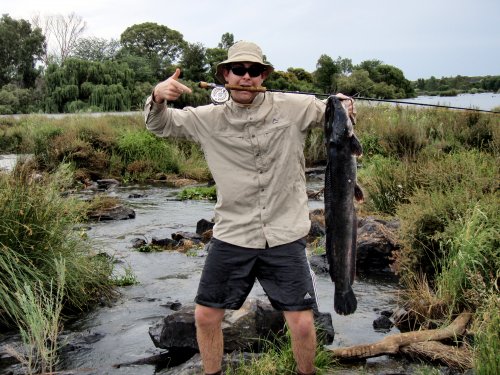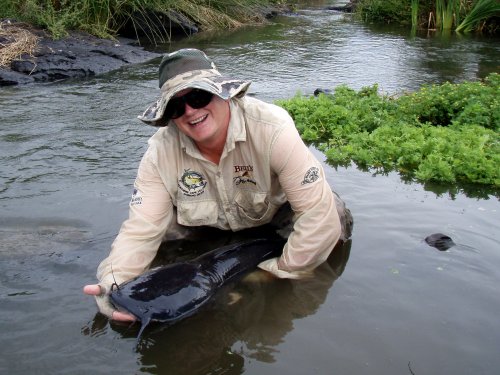Join Korrie Broos on a journey to fish for South African catfish or barbel as the catfish is locally known.
Soft notes of a violin gently flow from the speaker, a piano slowly complements the soothing rhythm. Add the some deeper sounds from a chello, gentle rhythm from kettle drums (gently) and the depth of brass, until you have a philharmonic orchestra making beautiful music. This illustrates the feelings I experience when fly fishing for trout with a light rod and small flies in crystal clear mountain streams.
However, while philharmonic music gently sooths my soul, I sometimes need something different. Ripping out the CD, pop a hard rock CD into the player.
Now the sound of a Stratocaster electric guitar rips thru the air, drums are hit with as much power and anger as possible and the lead singer screams the words at the top of his voice, along with the soul of the bass guitar.
I sometimes feel the same about my fly fishing and leave the ultra light tackle, tiny flies, and ultra thin tippets behind. I need a heavy rod and instant gratification.
Using a 6 to 9 weight rod, big bulky flies, thick tippets, and thumping my presentations down I'm hustling fish that will put a half circle in a heavyweight rod and pull with immense strength.
Do you sometimes feel like this about your fly fishing? If so, join me on a journey to fish for South African catfish or barbel as the catfish is locally known. Other calls them affectionately "Mr Whiskers"
Catfish or Barbel (Clarias gariepensis) now occurs in rivers and impoundments over virtually all of South Africa, due to inter-basin transfers and thoughtless fishermen.
From very cold clear water to warm dirty water, from scenic natural settings to urban drainage ditches, the catfish is at home in all of them. In the colder winter months they become a lot less active, with their activity increasing as water temperatures rise and they ready themselves for breeding.
Its distribution over a broad range of habitats makes the catfish the ideal target if you want a bit of seriously easy fishing fun. From 5 minutes, in a local city pond, to a drive of an hour or more through splendid settings, you can target the or barbel in just about any setting that you could wish for.
Just as Rock and Roll bands were considered the "bad boys" of music, Catfish are making the transition from being the unwanted "bad boys" of fly fishing to serious consideration as a worthwhile quarry.
Catfish are apex predators and scavengers, eating or attacking just about anything large and small, that moves, swims, smells or decomposes; a big bass guarding its nest, a decomposing carp, scattering baitfish, small ducks or ducklings bobbing on the surface, a weaver chick that falls from its woven grass nests overhanging the water, a water snake crossing a water body or a mouse can expect to be eaten.
So what will you require to target such formidable predators? As mentioned a heavier rod, from #6 to a #9. Depending on the water, the heavier the better, floating lines (but then again you could have just as much fun on a sinking line), tippet with a breaking strain from 5 kg to 10kg. Big bushy flies (a popular version is called a "half chicken"), preferably in darker colors, tied on STRONG HOOKS.
Barbel of up to 20 kg are not uncommon. Even a small one of 2 kg will give a good account of itself and test your skills and equipment. Your rod should have backbone - a lot of it, almost like rock and roll, the louder the better. Catfish can and will fight dirty, using structure, water flow and their powerful bodies to maximum effect. So, a rod with strong pulling power is a must to help you in the fight to subdue these giants. Otherwise you will loose lots of fish and many flies.
Reels are a personal choice, but make sure you have one with either or both of the following. A good drag system or an exposed rim that can be palmed.
A catfish of 5 kg can easily run you 30 to 40 meters into your backing and, in a decent flow of water, you can add at least another 20 meters. A large catfish of 15kg or 20kg might take a 100meters on its first run.
Any fly line will suffice, from a floater to a sinking line, depending on how you want to fish. Sometimes the catfish will feed on the bottom; then you can fish with a sinking line slowly stripping the flies, or a floating line with a long leader, making sure the fly reaches the bottom. At other times, catfish will skim the surface and, being highly selective under such circumstances, a floating line is a must.
Leaders can be very simple. A tapered leader works for presentation, but a straight taper of 5kg to 10kg is just as good for these "bad boys". Leader shy they are not. And you need as much pulling power as possible, most of the time. A large, strong landing net will come in very handy. But, small trout stream nets WILL NOT WORK. Imagine trying to net a 5kg, 10 kg or 15kg fish with a small trout net, now visualize the fish over a 1 meter long. Chaos, will happen, at a philharmonic concert, when a rock and roll band unexpectedly takes the main stage. Fighting catfish is visual, chaos, but the struggle can be very, very funny to watch. And rewarding when landing a big catfish.
Catfish prefer warmer water and warmer air temperatures. Spring, summer and autumn are the best months and time of day is important, since, as the water warms up barbel activity picks up.
How to catch catfish? As mentioned, they eat everything, dead or alive, swimming, floating, escaping or struggling to stay afloat. All you need to do is mimic any of these actions.
Your flies can be baitfish patterns, dragonflies or injured baitfish. Sometimes a large fly that can push lots of water will attract attention, at other times lots of flash will catch the barbel's eye. Poppers can draw big fish from deep areas. Just about any fly, presented right, will catch a catfish. Even a dry fly in the scum line will entice a Mr Wiskers.
Just as a rock band can switch from the most romantic ballad to some of the heaviest ear piercing percussion and guitar mixture, that some call music, so can a catfish change its eating habits.
From skimming the surface, do dropping down to the bottom of the lake, in a matter of seconds, so your fly fishing methods can and should be able to change.
At times the catfish will gently feed on the surface, and will be as spooky as a trout in a crystal clear mountain to a method, referred to as "calling catfish". When "calling catfish" you repeatedly cast into a certain good holding spot. Then let the fly sink. The fly will be taken any time from landing on the surface of the water, all the way thru the water column, until it reaches the bottom.
Other times, the best method will be to swing big flies down stream and then gently retrieving the fly upstream. Or on still waters, casting blind and retrieving at various depth, will also locate the catfish.
So if you feel like some heavy metal or serious rock and roll, fly fishing, cast a fly to South African catfish.














